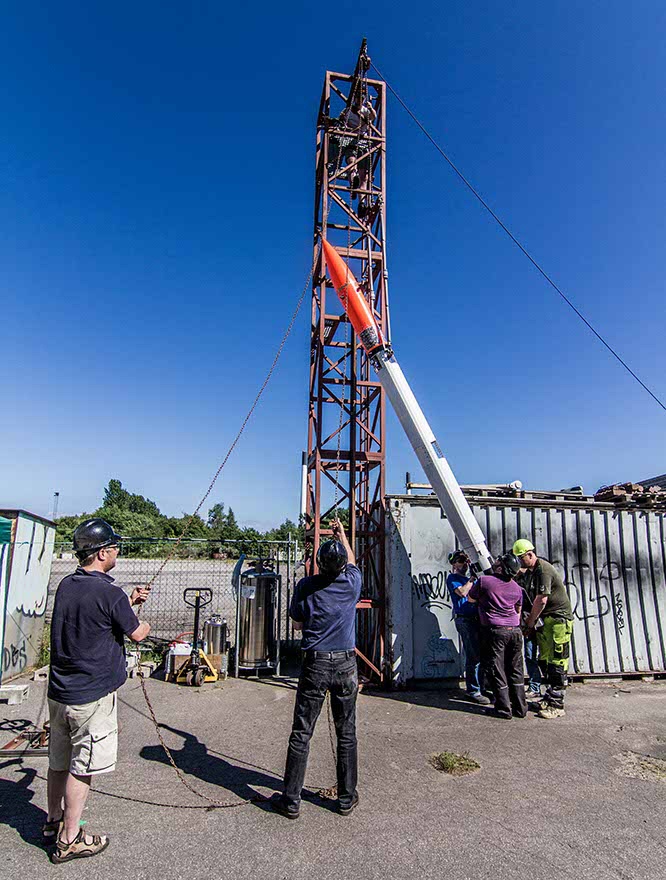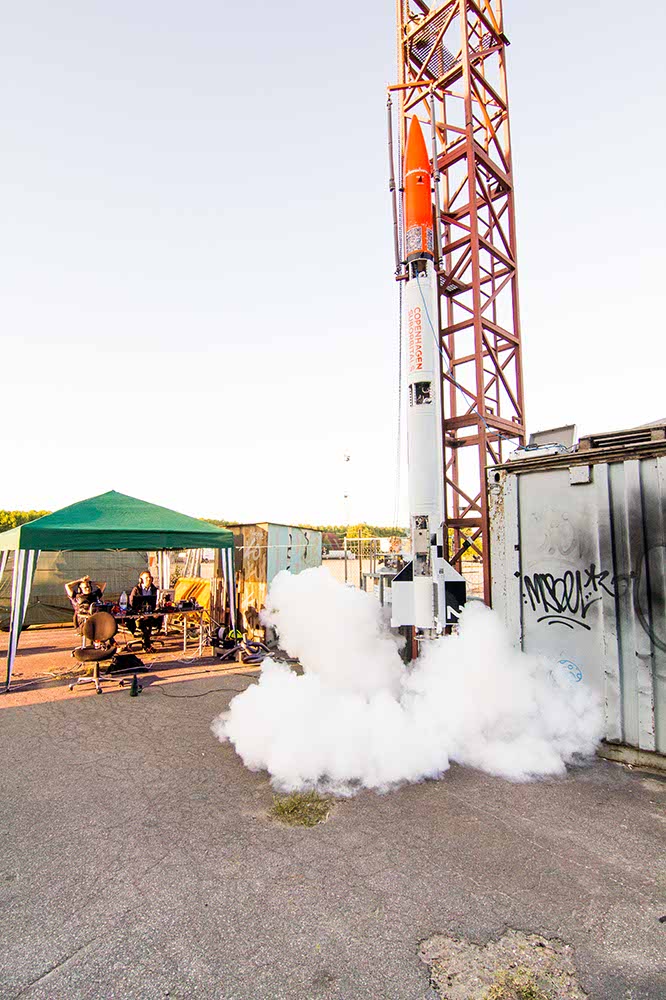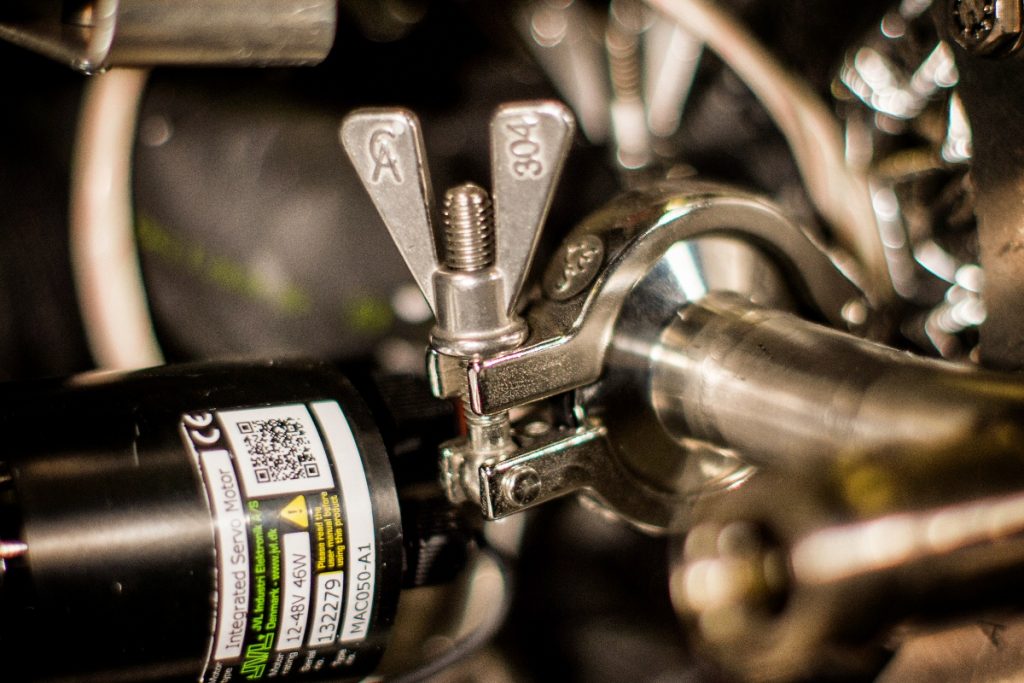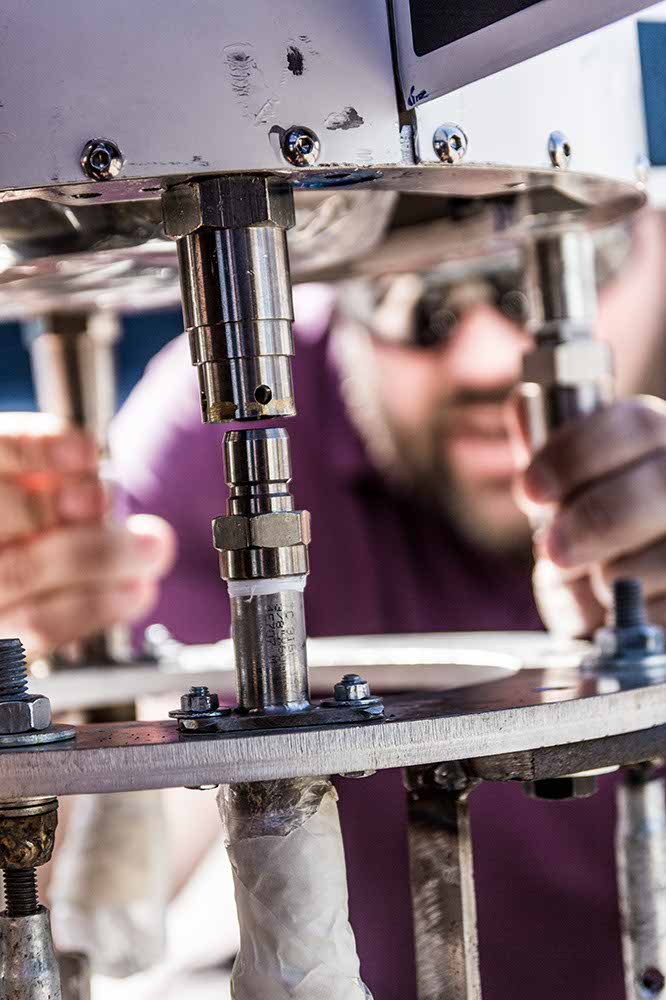Original blog in danish by Niels Foldager.
Nexø I is about to be launched. It’s time for the final tests of the completed rocket, and this Sunday the rocket was faced with – the literally icy – coldflow test.
The Nexø rocket is propelled by our 5 kN engine BPM5, running on 75% ethanol/25% water and liquid oxygen (LOX). The latter is cryogenic, having a temperature of -183 degrees centigrade (at 1 bar). To store a substance this cold onboard and having it present in the piping that feeds the engine put great demands on thermal isolation and poses special challenges for the design, electronics and moving parts.
The large thermal variations leads to relatively large variations in mechanical dimensions. When for instance aluminium has the thermal expansion coefficient 23 x 10^-6 m / (m x K), a 200 degree thermal change will result in a change in length of a hefty 4.6 mm per meter. Or – if the material cannot contract – a corresponding thermal tension. From this follows a natural need to test that the various valves and pipe joints are properly sealed when pressurised and exposed to temperature variations.
Mechanical parts such as valves can simply freeze up if the smallest amount of water or debris is present where it shouldn’t be. Moisture in the atmosphere will form frost which can challenge the tightness of electrical connectors and the like. We go to pains to disassemble and clean all components that can be disassembled “to LOX-grade” and subsequently storing all of them in sealed plastic bags until final assembly.
This makes it necessary to perform a coldflow test. We erect the assembled rocket on a dummy launch rail and fill the oxygentank with cryogenic fluid. The fluid is then left in the tank to “let it soak”. This is a simulation of the situation where the launch is delayed after LOX filling has been performed on the launch platform. In this very cold condition all electronic and mechanical functions are tested to see if they perform as expected.
Due to economical and other reasons we do not use LOX for the test, but substitute it with liquid nitrogen. This modification is feasible, as the test is harsher: The boiling point for nitrogen is lower than for LOX, at -196 C.

Fig. 2: Erection and mounting of the rocket was expedient and hasslefree. Photo: Jev Olsen / CS.

Fig. 3: LOX main valve is commanded open. “Mission Control” in the background. Photo: Jev Olsen / CS.

Fig. 4: If the rocket doesn’t break through the clouds, the clouds must be brought to the rocket . Photo: Jev Olsen / CS.
Nexø I has already been through this test: In September of 2015. At that occasion we had issues with the “vent valve” on the LOX tank which acted up, but the rocket passed the test overall.
How did Nexø I do at this test then?
We saw no problems with the telemetri or the electronics that had a part in the procedures.
The automatic pressurisation of the tanks also performed as expected.
At the September test an external power supply for the LOX main valve servo motor was causing problems. At this test the valve operated nominally when powered by the internal batteries.
The vent valves on both tanks also performed as expected.
Electronics, pressurisation, valves, servoes and batteries. Excellent!
But:
The tri-clamp joint fitting (search for “Tri-clamp fitting”) situated immediately below the LOX tank was leaking. Nitrogen dripped down the pipe and down into the engine compartment. Luckily these fittings and associated pipes are easy to disassemble for a closer inspection. A first test will probably be performed with gaseous nitrogen to assess the situation “on the crime site”.

Fig. 5: Tri-clamp fitting, this one is located elsewhere in the rocket. Photo: Carsten Olsen / CS.
Three modified quick couplings are placed on the bottom flange of the rocket, for helium pressurisation gas, nitrogen purge gas, and LOX tanking. The coupler counterparts are mounted on a flange, the coupling flange, which is a part of the Sputnik platform. The retaining parts of the couplings are removed, thus it is the weight of the rocket that keeps the coupling parts together. This means the rocket can elope at an opportune moment. The friction on the O-rings in the couplers was very large, which made mating problematic. The O-rings had simply been too thoroughly degreased during LOX grade cleaning (Sigh!). The problem was solved by a touch of LOX compatible fluorinated lubricant.

Fig. 6: “Thug behind bars”? No. Jacob is guiding the rocket onto the coupling flange. Photo: Jev Olsen / CS.
The LOX fill line pipe also located at the bottom of the rocket is equipped with a check valve to close off the pipe after liftoff. This valve was leaking at pressures above 10 bar. The problem is solved by adding a simple blind plug.
The fuel pressurisation coupling at the bottom of the rocket had a minor leak. It will be repacked.
A couple of O-rings needing lubrication, two pipe joints and a check valve leaking?
Not good enough. The rocket is flunked!
The readout from the load cell varied +- 15% when the rocket was moved sideways on the rail to simulate platform movements at sea.
The most reasoable explanation seems to be that the upper end of the load cell rod which carry the rocket, described one spherical surface while the coupling flange described another, caused by the two radii being of differing length and having different center placements.
This resulted in the rocket and the coupling flange being unable to move identically. The differences could be absorbed by the coupling between the two, but the large friction (described above) in the couplings allowed for relatively large unwanted forces to be transferred to the load cell.
Apart from the already mentioned lubrication of the couplers’ O-rings, the geometri also need to be adjusted, for instance by letting the load cell rod carry the coupling flange.
We’re looking into this.
The process of charging the internal batteries in the rocket has turned out to be cumbersome and akward.
A modification of umbillical cable and charger parameters is expected to rectify this.
Independent of the test – before the rocket was rolled to the launch rail – we observed that the guidance and navigation computer (GNC) did not deliver telemetri data to the radios. This was confirmed functional at an earlier test, and we are having a hard look at it.
So no major issues remain to be solved.
The rocket is granted a re-examination:
The leaks described above have been fixed and Nexø I is now pressurised to 4 bars to check for leaks. We plan a new coldflow test this coming weekend. The coldflow test is after all – in addition to the static test of the engine – the essense of the Nexø I FAT (Factory Acceptance Test).
Sputnik have arrived in Copenhagen and we will soon progress to the Nexø I HAT (Habour Acceptance Test) and SAT (Sea Acceptance Test).
Yes !






1 Comment
Comments are closed.